Precipitation and Flow Variations in the Lancang–Mekong River Basin and the Implications of Monsoon Fluctuation and Regional Topography
Abstract
1. Introduction
2. Materials and Methods
2.1. Study Area
2.2. Data Source
2.2.1. Global Precipitation Climatology Centre (GPCC) data
2.2.2. Rain Gauge Data
2.2.3. Flow Data
2.2.4. Monsoon Index
2.2.5. Wind Data
2.3. Precipitation Variation Analysis
3. Results
3.1. Spatial Distribution of Precipitation
3.2. Spatiotemporal Variations of Precipitation
3.3. Topographic Interaction
3.4. Link between Monsoon and River Flow
4. Discussion
5. Conclusions
- Changes in precipitation were found more synchronous with the WNPSM than with the ISM. Fluctuation of the WNPSM primarily influenced precipitation variation on the downstream left bank, and 29.3% of the basin was found to exhibit significant positive correlation with the WNPMI. In comparison, fluctuation of the ISM mainly affected the western boundary of the lower Lancang–Mekong River Basin, and the affected area was much less.
- Topographic features amplified the effects of WNPSM fluctuation. During the strong WNPSM years, the anomalous westerlies crossing the Annamite Mountains carried greater quantities of water vapor that result in enhanced orographic precipitation on the windward side, and vice versa.
- River flow below Nong Khai station was found to be positively and significantly correlated with the WNPMI, which was consistent with the area where most of this river flow was generated, and precipitation variation was induced by WNPSM fluctuation. At the Mukdahan, Pakse and Stung Treng stations, the differences in flow between strong and weak monsoon years were 13.0%, 20.7% and 31.6%, respectively, indicating that the WNPMI would be helpful for long-term hydrological predictions.
Author Contributions
Funding
Acknowledgments
Conflicts of Interest
References
- Framing research on Water Resources Management and Governance in Cambodia: A Literature Review; Working paper 37; CDRI (Cambodia Development Resource Institute): Phnom Penh, Cambodia, 2008.
- State of the Basin Report; MRC (Mekong River Commission): Vientiane, Laos, 2010.
- Food and Agriculture Organization of the United Nations. Available online: http://www.fao.org/nr/water/aquastat/basins/mekong/ (accessed on 12 July 2019).
- Ruan, Y.F.; Yao, Z.J.; Wang, R.; Liu, Z.F. Ranking of CMIP5 GCM skills in simulating observed precipitation over the Lower Mekong Basin, using an improved score-based method. Water 2018, 10, 1868. [Google Scholar] [CrossRef]
- Xue, Z.; Liu, J.P.; Ge, Q. Changes in hydrology and sediment delivery of the Mekong River in the last 50 years: Connection to damming, monsoon, and ENSO. Earth Surf. Process. Landf. 2011, 36, 296–308. [Google Scholar] [CrossRef]
- Buckley, B.M.; Fletcher, R.; Wang, S.Y.S.; Zottoli, B.; Pottier, C. Monsoon extremes and society over the past millennium on mainland Southeast Asia. Quat. Sci. Rev. 2014, 95, 1–19. [Google Scholar] [CrossRef]
- Nguyen, T.V.; Mai, K.V.; Nguyen, P.N.B.; Juang, H.M.H.; Nguyen, D.V. Evaluation of summer monsoon climate predictions over the Indochina Peninsula using regional spectral model. Weather Clim. Extrem. 2019, 23, 100195. [Google Scholar] [CrossRef]
- Delgado, J.M.; Merz, B.; Apel, H. A climate-flood link for the lower Mekong River. Hydrol. Earth Syst. Sci. 2012, 16, 1533–1541. [Google Scholar] [CrossRef]
- Unverricht, D.; Nguyen, T.C.; Heinrich, C.; Szczuciński, W.; Lahajnar, N.; Stattegger, K. Suspended sediment dynamics during the inter-monsoon season in the subaqueous Mekong Delta and adjacent shelf, southern Vietnam. J. Asian Earth Sci. 2014, 79, 509–519. [Google Scholar] [CrossRef]
- Tatsumia, K.; Yamashikib, Y. Effect of irrigation water withdrawals on water and energy balance in the Mekong River Basin using an improved VIC land surface model with fewer calibration parameters. Agric. Water Manag. 2015, 159, 92–106. [Google Scholar] [CrossRef]
- Hoang, L.P.; Lauri, H.; Kummu, M.; Koponen, J.; van Vliet, M.T.H.; Supit, I.; Leemans, R.; Kabat, P.; Ludwig, F. Mekong River flow and hydrological extremes under climate change. Hydrol. Earth Syst. Sci. 2016, 20, 3027–3041. [Google Scholar] [CrossRef]
- Lauri, H.; de Moel, H.; Ward, P.J.; Räsänen, T.A.; Keskinen, M.; Kummu, M. Future changes in Mekong River hydrology: Impact of climate change and reservoir operation on discharge. Hydrol. Earth Syst. Sci. 2012, 16, 4603–4619. [Google Scholar] [CrossRef]
- Arias, M.E.; Cochrane, T.A.; Piman, T.; Kummu, M.; Caruso, B.S.; Killeen, T.J. Quantifying changes in flooding and habitats in the Tonle Sap Lake (Cambodia) caused by water infrastructure development and climate change in the Mekong Basin. J. Environ. Manag. 2012, 112, 53–66. [Google Scholar] [CrossRef]
- Sridhar, V.; Kang, H.; Ali, S.A. Human-induced alterations to land use and climate and their responses for hydrology and water management in the Mekong River Basin. Water. 2019, 11, 1307. [Google Scholar] [CrossRef]
- Yuan, L.; He, W.J.; Liao, Z.Y.; Degefu, D.M.; An, M.; Zhang, Z.F.; Wu, X. Allocating water in the Mekong River Basin during the dry season. Water. 2019, 11, 400. [Google Scholar] [CrossRef]
- Liu, Y.Y.; Ding, Y.H. Influence of the western North Pacific summer monsoon on summer rainfall over the Yangtze River Basin. Chin. J. Atmos. Sci. 2009, 33, 1225–1237. (In Chinese) [Google Scholar]
- Tsai, C.; Behera, S.K.; Waseda, T. Indo–China monsoon indices. Sci Rep. 2015, 5, 8107. [Google Scholar] [CrossRef] [PubMed]
- Yang, R.; Zhang, W.K.; Gui, S.; Tao, Y.; Cao, J. Rainy season precipitation variation in the Mekong River basin and its relationship to the Indian and East Asian summer monsoons. Clim. Dyn. 2018, 52, 5691–5708. [Google Scholar] [CrossRef]
- Chang, C.P.; Wang, Z.; Mcbride, J.; Liu, C.H. Annual cycle of Southeast Asia-Maritime Continent rainfall and the asymmetric monsoon transition. J. Clim. 2005, 18, 287–301. [Google Scholar] [CrossRef]
- Wang, Z.; Chang, C.P. A numerical study of the interaction between the large-scale monsoon circulation and orographic precipitation over South and Southeast Asia. J. Clim. 2012, 25, 2440–2455. [Google Scholar] [CrossRef]
- Räsänen, T.A.; Kummu, M. Spatiotemporal influences of ENSO on precipitation and flood pulse in the Mekong River Basin. J. Hydrol. 2013, 476, 154–168. [Google Scholar] [CrossRef]
- Overview of the Hydrology of the Mekong Basin; MRC (Mekong River Commission): Vientiane, Laos, 2005.
- Costa-Cabral, M.C.; Richey, J.E.; Goteti, G.; Lettenmaier, D.P.; Feldkötter, C.; Snidvongs, A. Landscape structure and use, climate, and water movement in the Mekong River basin. Hydrol. Process. 2008, 22, 1731–1746. [Google Scholar] [CrossRef]
- Luo, X.; Wu, W.Q.; He, D.M.; Li, Y.G.; Ji, X. Hydrological simulation using TRMM and CHIRPS precipitation estimates in the Lower Lancang–Mekong River Basin. Chin. Geogr. Sci. 2019, 29, 13–25. [Google Scholar] [CrossRef]
- Becker, A.; Finger, P.; Meyer-Christoffer, A.; Rudolf, B.; Schamm, K.; Schneider, U.; Ziese, M. A description of the global land-surface precipitation data products of the Global Precipitation Climatology Centre with sample applications. Earth Syst. Sci. Data 2013, 5, 71–99. [Google Scholar] [CrossRef]
- Schneider, U.; Becker, A.; Finger, P.; Meyer-Christoffer, A.; Ziese, M.; Rudolf, B. GPCC’s new land surface precipitation climatology based on quality-controlled in situ data and its role in quantifying the global water cycle. Theor. Appl. Climatol. 2013, 115, 15–40. [Google Scholar] [CrossRef]
- Fuchs, T.; Schneider, U.; Rudolf, B. The Global Precipitation Climatology Centre (GPCC)—In situ observation-based precipitation climatology on regional and global scale. In Proceedings of the EGU General Assembly, Vienna, Austria, 19–25 April 2009. [Google Scholar]
- Schneider, U.; Finger, P.; Meyer-Christoffer, A.; Ziese, M.; Becker, A. GPCC Global Precipitation Analysis Products of the GPCC; Deutscher Wetterdienst: Offenbach, Germany, 2018. [Google Scholar]
- Duan, Z.; Liu, J.Z.; Tuo, Y.; Chiogna, G.; Disse, M. Evaluation of eight high spatial resolution gridded precipitation products in Adige Basin (Italy) at multiple temporal and spatial scales. Sci. Total Environ. 2016, 573, 1536–1553. [Google Scholar] [CrossRef] [PubMed]
- Wang, B.; Wu, R.; Lau, K.M. Interannual variability of the Asian summer monsoon: Contrasts between the Indian and the western North Pacific-East Asian monsoons. J. Clim. 2001, 14, 4073–4090. [Google Scholar] [CrossRef]
- Tošić, I.; Hrnjak, I.; Gavrilov, M.B.; Unkašević, M.; Marković, S.B.; Lukić, T. Annual and seasonal variability of precipitation in Vojvodina, Serbia. Theor Appl Climatol. 2014, 117, 331–341. [Google Scholar] [CrossRef]
- Hsu, H.H.; Zhou, T.; Matsumoto, J. East Asian, Indochina and Western North Pacific Summer Monsoon - an update. Asia-Pac. J. Atmos. Sci. 2014, 50, 45–68. [Google Scholar] [CrossRef]
- Kale, V. On the link between extreme floods and excess monsoon epochs in South Asia. Clim. Dyn. 2011, 39, 1107–1122. [Google Scholar] [CrossRef]
- Sang, Y.F.; Singh, V.P.; Gong, T.L.; Xu, K.; Sun, F.B.; Liu, C.M.; Liu, W.B.; Chen, R.Z. Precipitation variability and response to changing climatic condition in the Yarlung Tsangpo River basin. China. J. Geophys. Res. Atmos. 2016, 121, 8820–8831. [Google Scholar] [CrossRef]
- Nishat, B.; Rahman, S.M.M. Water resources modeling of the Ganges–Brahmaputra–Meghna River Basins using satellite remote sensing data. J. Am. Water Resour. Assoc. 2009, 45, 1313–1327. [Google Scholar] [CrossRef]
- Curtis, S.; Crawford, T.; Rahman, M.; Paul, B.; Miah, M.G.; Islam, M.R.; Patel, M. A hydroclimatological analysis of precipitation in the Ganges–Brahmaputra–Meghna River Basin. Water 2018, 10, 1359. [Google Scholar] [CrossRef]
- Webster, P.J.; Toma, V.E.; Kim, H.M. Were the 2010 Pakistan floods predictable. Geophys. Res. Lett. 2011, 38, 30–31. [Google Scholar] [CrossRef]
- Hartmann, H.; Andresky, L. Flooding in the Indus River basin -A spatiotemporal analysis of precipitation records. Glob. Planet. Chang. 2013, 107, 25–35. [Google Scholar] [CrossRef]
- Pervez, M.S.; Henebry, G.M. Spatial and seasonal responses of precipitation in the Ganges and Brahmaputra river basins to ENSO and Indian Ocean dipole modes: Implications for flooding and drought. Nat. Hazards Earth Syst. Sci. 2015, 15, 147–162. [Google Scholar] [CrossRef]
- Hasson, S.U.; Pascale, S.; Lucarini, V.; Böhner, J. Seasonal cycle of precipitation over major river basins in South and Southeast Asia: A review of the CMIP5 climate models data for present climate and future climate projections. Atmos. Res. 2016, 180, 42–63. [Google Scholar] [CrossRef]
- Dimri, A.P.; Thayyen, R.; Kibler, K.; Stanton, A.; Jain, S.K.; Tullos, D.; Singh, V.P. A review of atmospheric and land surface processes with emphasis on flood generation in the Southern Himalayan rivers. Sci. Total Environ. 2016, 556, 98–115. [Google Scholar] [CrossRef] [PubMed]
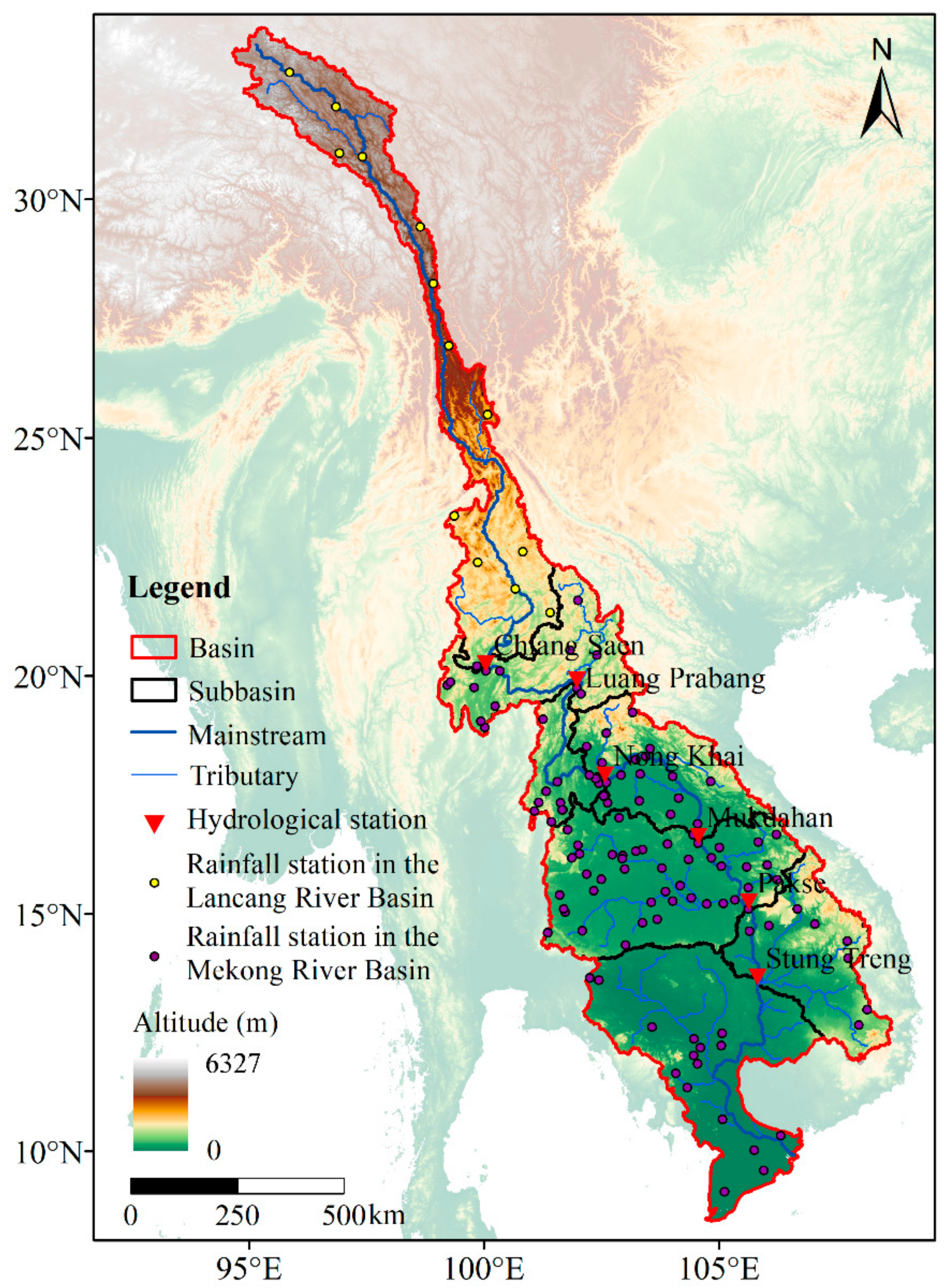
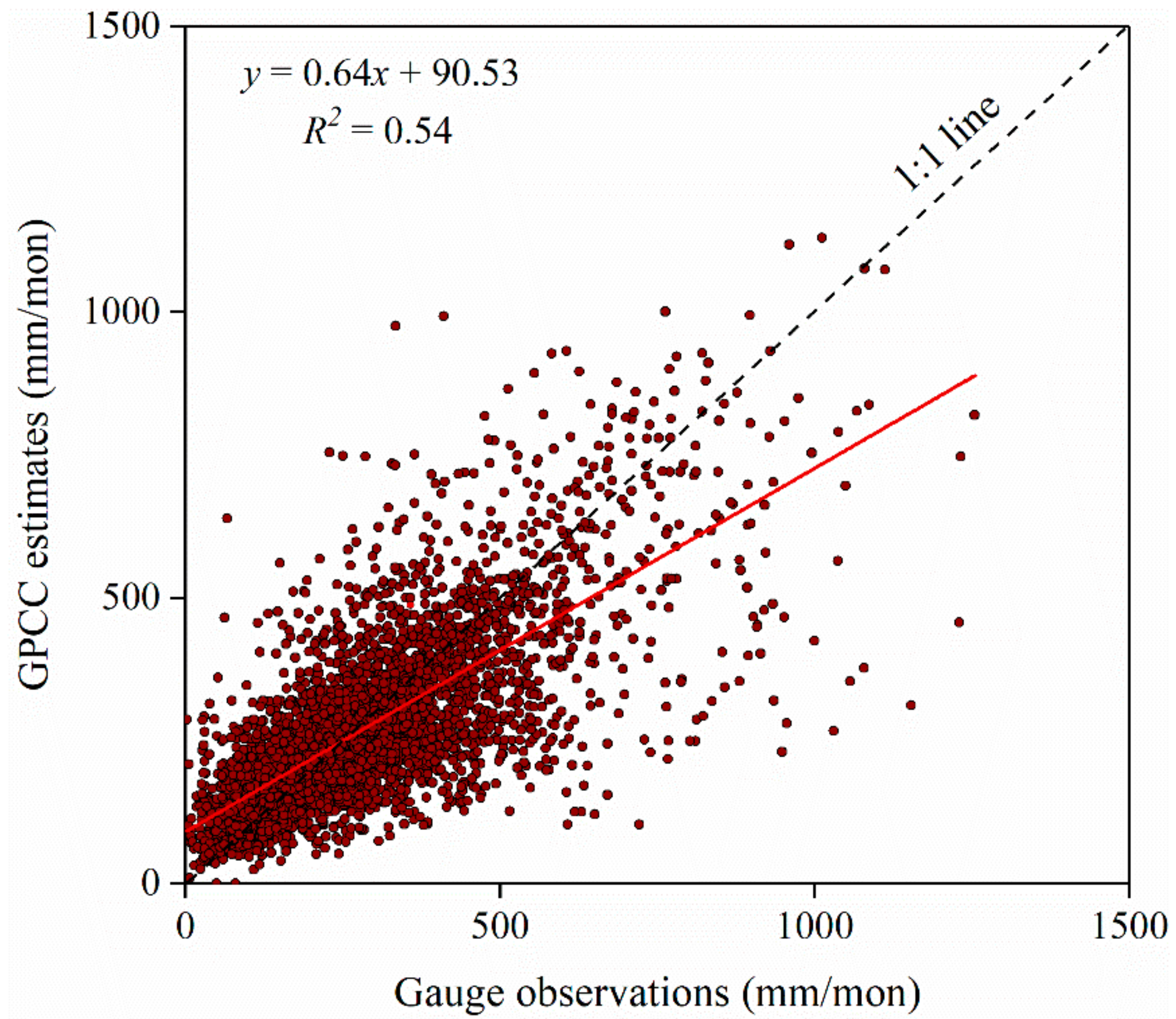
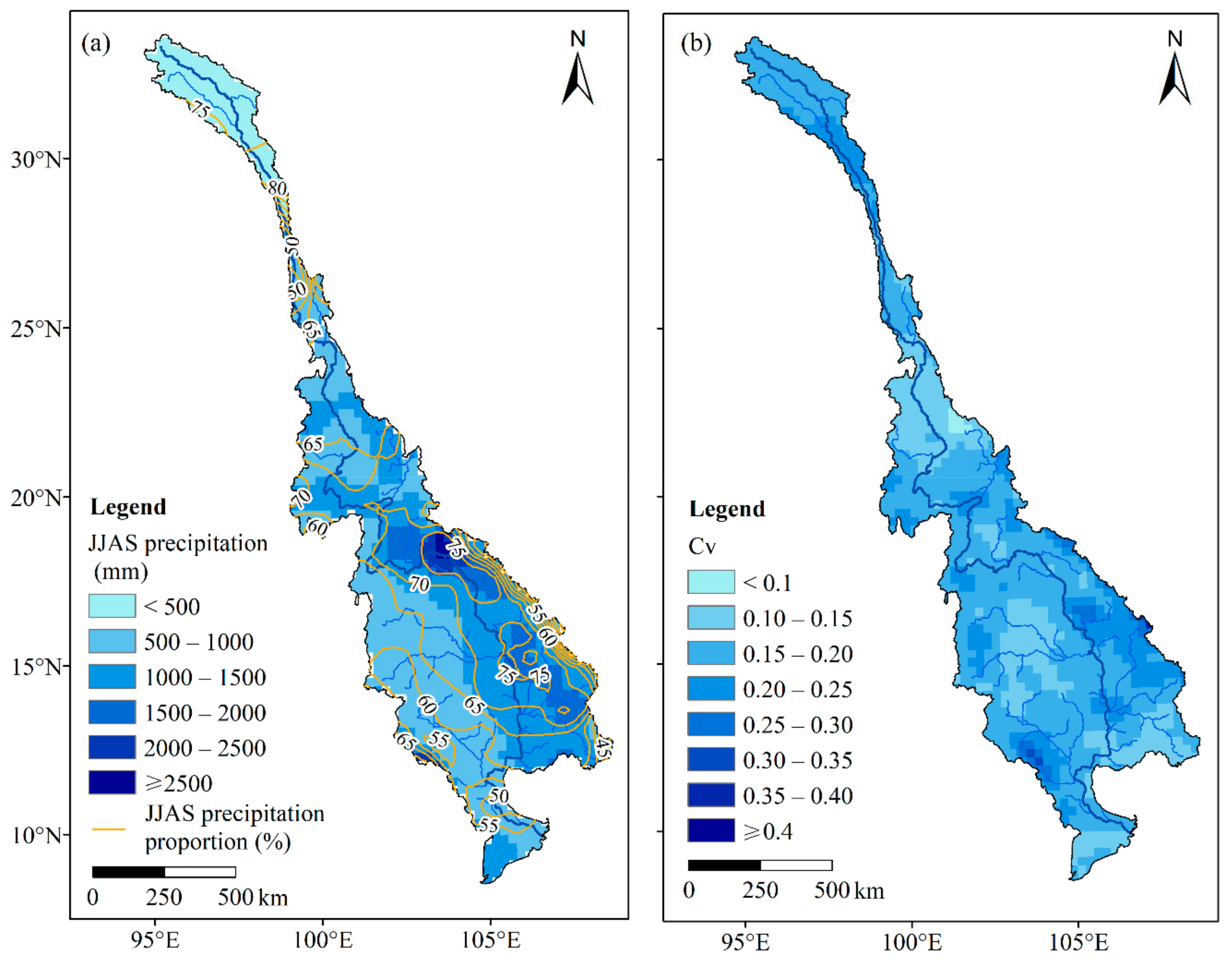
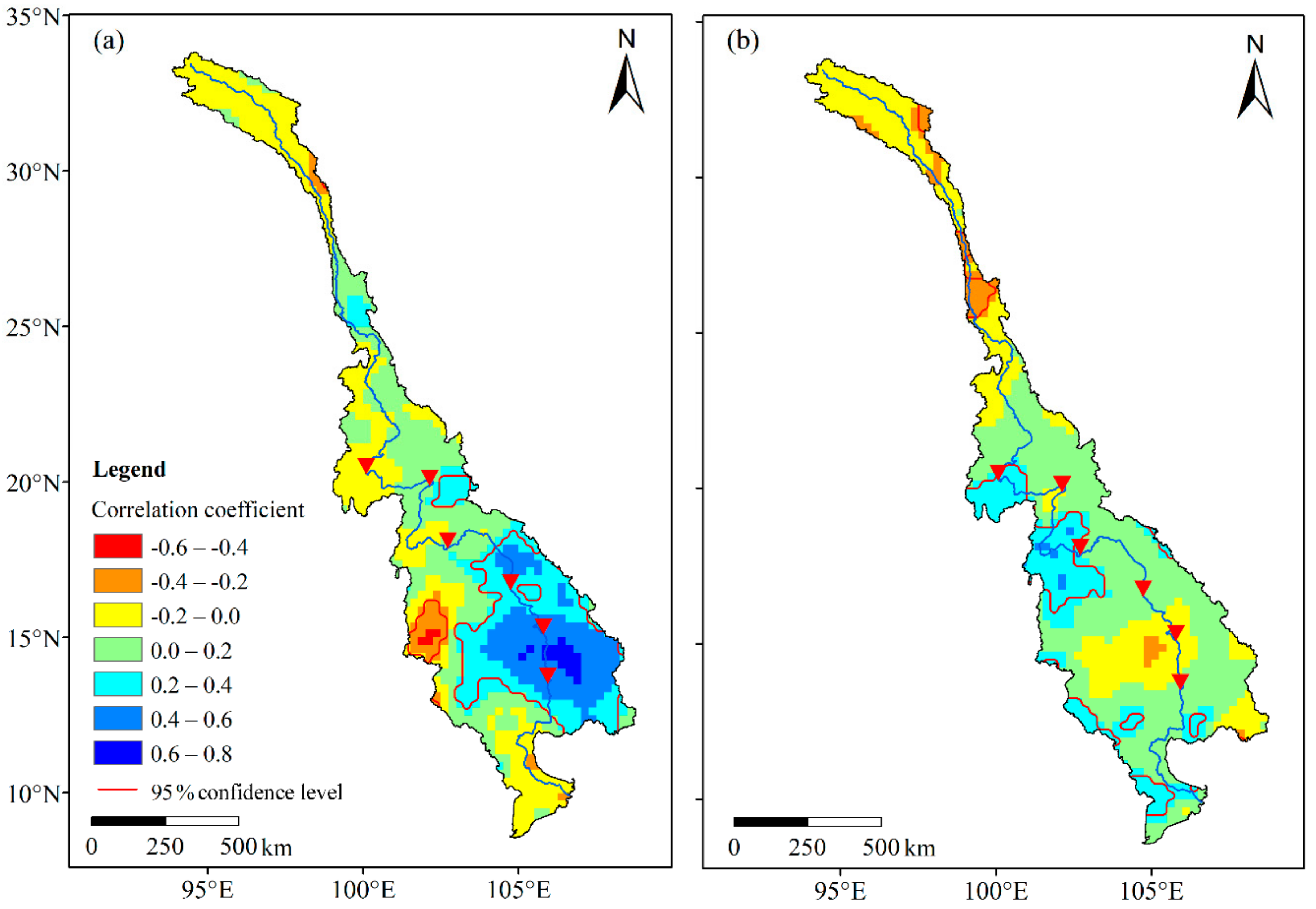


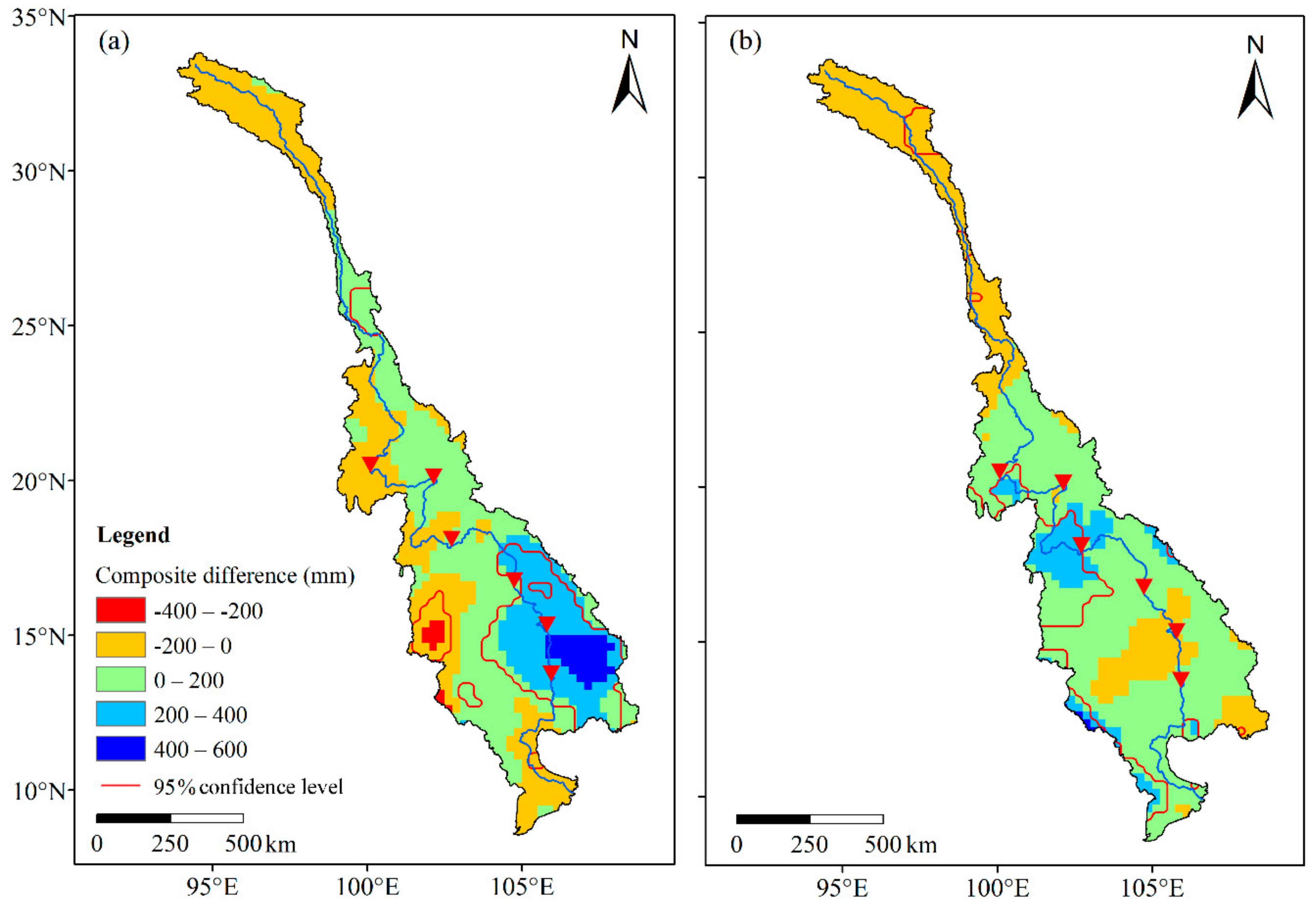
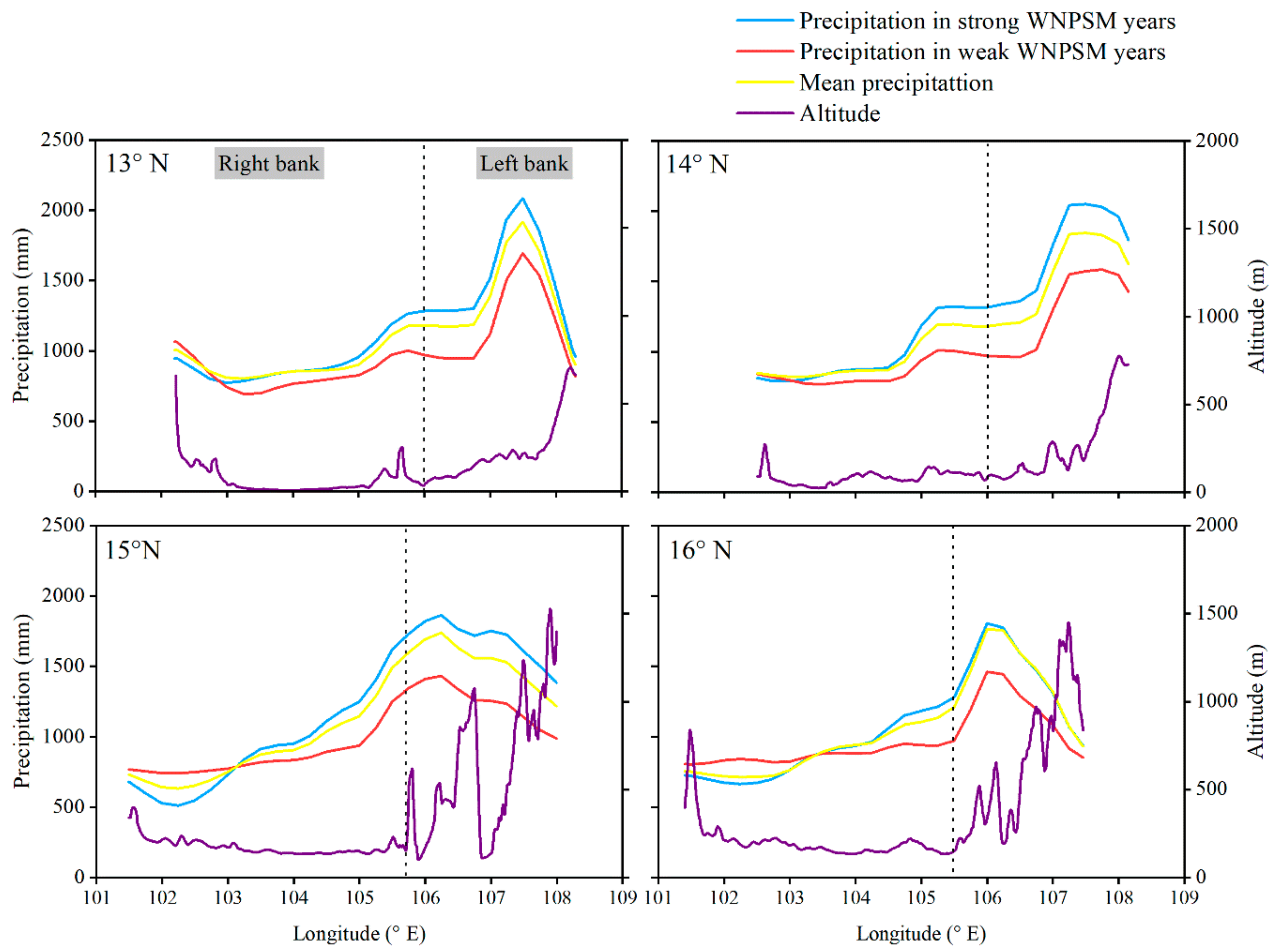
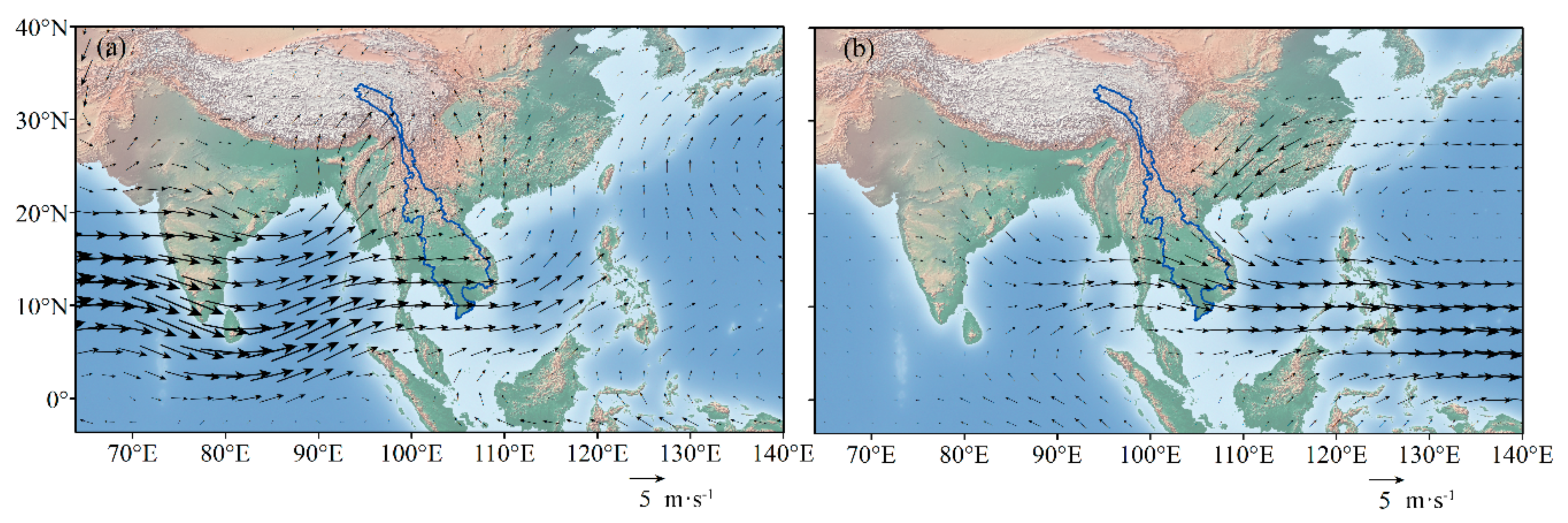

| Hydrological Station | Drainage Area (103 km2) | Annual Flow (109 m3) |
|---|---|---|
| Chiang Saen | 189 | 85 |
| Luang Prabang | 268 | 123 |
| Nong Khai | 302 | 142 |
| Mukdahan | 391 | 240 |
| Pakse | 545 | 306 |
| Stung Treng | 635 | 413 |
| Sub-basin | WNPMI | IMI |
|---|---|---|
| Above Chiang Saen | −0.07 | 0.19 |
| Chiang Saen-Luang Prabang | 0.20 | 0.16 |
| Luang Prabang-Nong Khai | 0.11 | 0.20 |
| Nong Khai-Mukdahan | 0.42 ** | −0.11 |
| Mukdahan-Pakse | 0.34 * | 0.09 |
| Pakse-Stung Treng | 0.58 ** | 0.04 |
© 2019 by the authors. Licensee MDPI, Basel, Switzerland. This article is an open access article distributed under the terms and conditions of the Creative Commons Attribution (CC BY) license (http://creativecommons.org/licenses/by/4.0/).
Share and Cite
Fan, X.; Luo, X. Precipitation and Flow Variations in the Lancang–Mekong River Basin and the Implications of Monsoon Fluctuation and Regional Topography. Water 2019, 11, 2086. https://doi.org/10.3390/w11102086
Fan X, Luo X. Precipitation and Flow Variations in the Lancang–Mekong River Basin and the Implications of Monsoon Fluctuation and Regional Topography. Water. 2019; 11(10):2086. https://doi.org/10.3390/w11102086
Chicago/Turabian StyleFan, Xuemei, and Xian Luo. 2019. "Precipitation and Flow Variations in the Lancang–Mekong River Basin and the Implications of Monsoon Fluctuation and Regional Topography" Water 11, no. 10: 2086. https://doi.org/10.3390/w11102086
APA StyleFan, X., & Luo, X. (2019). Precipitation and Flow Variations in the Lancang–Mekong River Basin and the Implications of Monsoon Fluctuation and Regional Topography. Water, 11(10), 2086. https://doi.org/10.3390/w11102086





